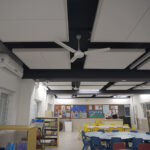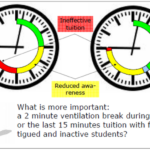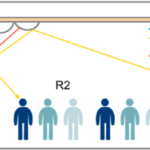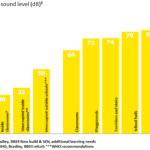Seth MR Jaipuriya school in Lucknow, India, recently underwent a major upgrade with Team 3 Architects in New Delhi, bringing the school confidently into the 21st Century. Luckily, the acoustics were not forgotten and were, in fact, a main concern for the Principal, Promini Chopra, who speaks in the video below. “After 25-26 years, we […]
classroom acoustics
Improving acoustic conditions at Mount Abu School in Delhi, India
Mount Abu School in Delhi, India, prides itself in providing the most advanced and optimized learning environments for its learners. That’s why the school offers an impressive array of technology for students like 3D printers and robotics, and also houses a STEM excellence center. But the acoustic conditions left a lot to be desired. After […]
Designing quality learning spaces in over 600 schools in New Zealand
As part of their School Property Strategy, New Zealand’s Ministry of Education (MoE) has recently revamped their acoustic standard for education, Designing Quality Learning Spaces (DQLS), and aims to implement it across 3,000 learning spaces in over 600 schools. The initiatives were recently presented at the Internoise 2022 conference by James Whitlock from Marshall Day […]
New research shows that a lower reverberation time helps children cope with multi-talker listening situations
How children make sense of the complex signals they hear in the classroom depends partly on their hearing and cognitive abilities. But newly published research shows more about the important part played by the acoustic environment in this process; specifically, the role of reverberation time. The ability to make sense of what you are hearing […]
Embracing Aural Diversity in Education through Universal Design for Learning
Classrooms the world over are filled with children that have a range of hearing conditions: from tinnitus and hearing loss to glue ear and noise sensitivity (hyperacusis). Meanwhile, schools claim to be “inclusive” without accommodating this aural diversity in any way. How can they achieve real inclusivity and accessibility by applying some of the core […]
Noisier teaching methods pose serious challenges for classroom design
Teaching methods shape the classroom sound environment Teachers of today have the shared goal of maximizing student engagement whilst maintaining a controlled sound environment. This has resulted in decades of innovation in educational approaches, classroom design and acoustic standardization. When additionally considering the influence of advancements in technological tools which have further augmented the field […]
Good acoustics and air quality combine to increase student concentration, well being and learning conditions
Good classroom design works as a 3rd Pedagogue! In a post-Covid world this applied study has become even more relevant to ensure sustainable teaching and learning environments. This research carried out by University of Bremen ISF – Institute for interdisciplinary School Research into the impact of improving ventilation was based on previous studies (Bremen III) […]
Combination of Absorbers and Diffusers – An Experimental Study in a Classroom
This study provides information on how different acoustic treatments can be used to obtain different room acoustic qualities, and can be used to improve and fine-tune the room acoustic parameters for better speech and listening conditions in classrooms. The background overview The most common acoustical treatment in ordinary classrooms is a suspended sound absorbing ceiling. […]
Heart rate is a medically recognised stressor – Noise reduction gives teachers a significant long-term benefit
This is not new, however it is a fundamental aspect to consider when designing optimal sustainable indoor environments. By measuring/recording the heart rate of teachers, an indicator of stress was apparent in lessons and also over a longer more sustained period. Here is a short insight overview on stress as stated by ASA (American Heart […]
The impact of noise in education – a research summary
This new research summary is now available and lifts out evidence from a variety of research studies around the world. These studies address a broad range of important aspects which need to be considered in learning environments. It is based on a recent extensive literature review by Professor Emerita Bridget Shield made for Ecophon. We […]











